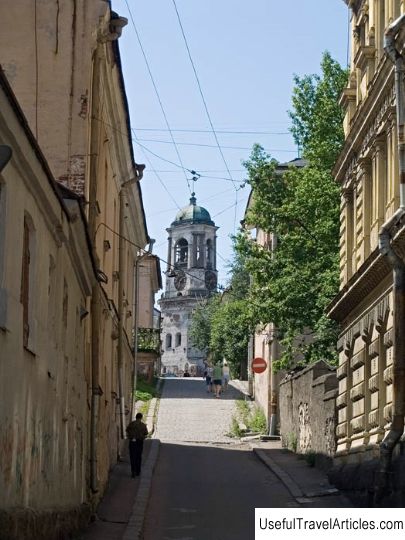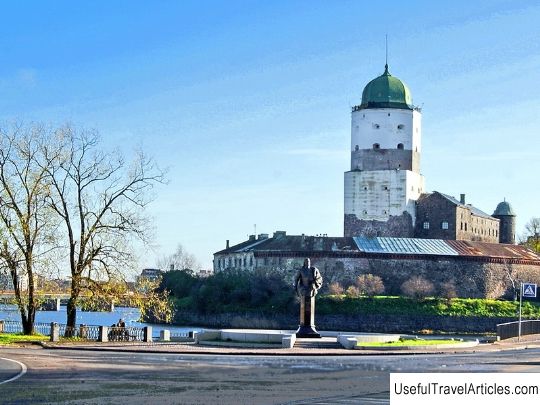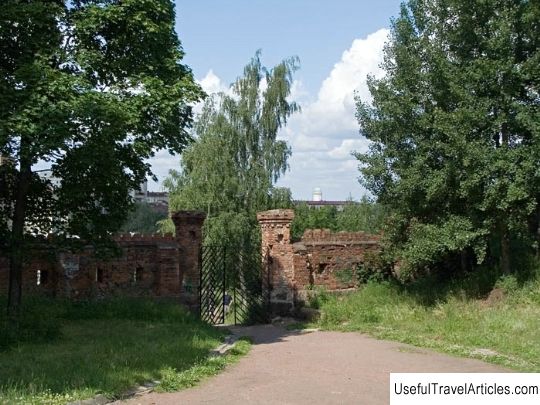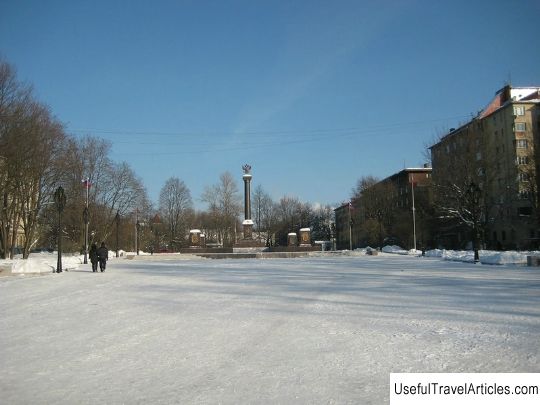Vyborg castle description and photo - Russia - Leningrad region: Vyborg
Rating: 7,8/10 (1542 votes) 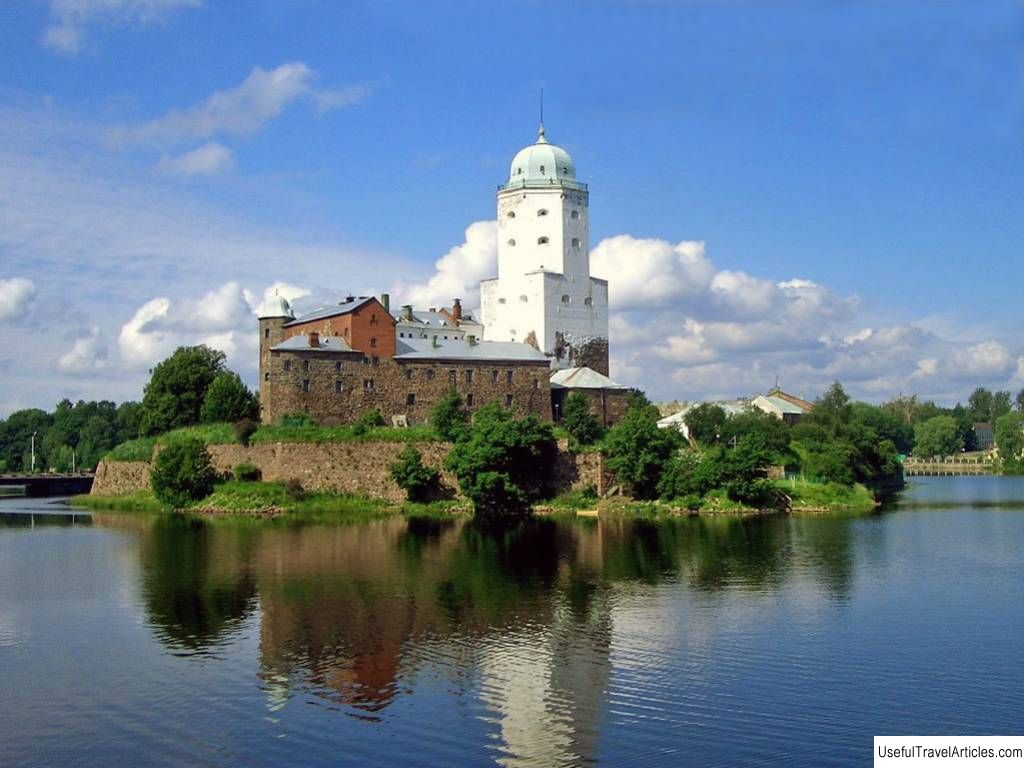
Vyborg castle description and photos - Russia - Leningrad region: Vyborg. Detailed information about the attraction. Description, photos and a map showing the nearest significant objects. Photo and descriptionThe main attraction and architectural dominant of modern Vyborg is a real medieval castle of the XIII century on the Castle Island . Strong walls, a high donjon with an observation deck, exhibitions and museum expositions - all this invariably attracts many tourists here. Until the beginning of the 18th century, the territory of Vyborg belonged to Sweden. The city itself arose around the small fortress of St. Olaf, founded in the 13th century. In the 16th century, another fortress appeared here, and under Peter the Great, all these places became part of the Russian Empire. The city on the border is being fortified, new forts and walls are being built here. From 1918 to 1940, Vyborg belongs to Finland, and in 1940, according to the Moscow Peace Treaty, it goes to the USSR. The ancient castle has survived to this day - it is he who is the main attraction of the modern city. FortressIn the XII century, the Karelian tribe lived in these places, and in fact they were controlled by Veliky Novgorod . On a small island there was a small wooden Karelian fortress . In the middle to the end of the XIII century, from Western Europe, they regularly undertake campaigns here in order to bring Western Christianity to these lands, as well as to get their hands on them. Now all these hostilities are usually called the "Northern Crusades", the most famous episode of which is the famous Battle of the Ice in 1242 . This movement involves the Livonians, Germans, Prussians and Swedes. During one of the last such campaigns, in 1293, the Karelian fortress was captured by the Swedes and burned. The Swedes built a stone castle here to establish final control over the territory of the Karelian Isthmus and confront the Novgorod Republic. The founder of the castle and the city was the actual ruler of Sweden Torkel Knutsson , regent under the minor king Birger. Having fortified here, he continued the conquest - he tried to recapture the mouth of the Neva from the Novgorodians and founded another fortress there - Landxron on the Okhta River. But this attempt failed, the Novgorodians quickly recaptured the new fortress and took it for themselves, and Knutsson was forced to return to Sweden. The grown-up king began to show independence. The career of the founder of Vyborg ended with the fact that he was slandered by enemies and beheaded by his pupil. Its total height together with the rock on which it was built is 75 meters. The lower part of the tower has remained practically unchanged since the 13th century, while the upper part has been rebuilt several times, most recently at the end of the 19th century. The interior of the tower was burnt out in the middle of the 19th century and since then the floors have not been restored. Now there are only wooden staircases and transitions up to the observation deck. At the end of the 19th century, a porch and a staircase leading to the tower appeared. Even when the fortress ceased to be Knutsson's residence, a large garrison remained here, which was ruled by the governor of the castle, and a whole town. In the middle of the 15th century, the fortress was rebuilt and strengthened. The money for the construction is allocated by the young commandant of the fortress Karl Knutsson Bund , the future king of Sweden and Norway, Charles VIII. Vyborg is then not just a fortress, but the center of a whole region - the Vyborg Lena, which Karl Knutsson rules as his own little king. Contemporaries wrote that the castle could not be found more beautiful than Vyborg. It was under him that a crenellated defensive wall appeared - the outer wall of the castle with square combat towers. The courtyards were paved and the interiors of the living quarters were renewed. A little later, a third line of walls arose - no longer on the island itself. The third wall with nine towers defended the city, which grew up on the peninsula in front of the castle. In the 17th century , the castle was again fortified and rebuilt. The main tower is being built, the coastlines are being fortified, the commandant's house is being rebuilt, new barracks are being built. They care not only about efficiency, but also about beauty - ponds appear on the territory of the castle and even a fountain is arranged. In the summer of 1710, Vyborg takes part in hostilities. Peter I siege for two whole months, until finally the commandant surrenders to the mercy of the victor. In the museum you can now see a colorful model dedicated to the siege of the castle. After that, the fortress loses its military significance. In the 18th-19th centuries, it was used as a armory and prison . And in the middle of the 19th century, they tried to organize a festive fireworks display - and as a result, a terrible fire happened. Olaf's Tower burns out almost completely from the inside, and other premises have suffered as well. At the end of the 19th century, restoration took place, but the castle is still practically not used until the creation of a museum in it already in the Soviet years. Now the Vyborg castle is a whole complex of structures. This is Olaf's tower with an observation deck and a courtyard, three courtyards on the sides of the castle. Upper courtyard, lower courtyard and artisan courtyard with a small smithy. Here you can see the old buildings of the arsenals of the 17th century, which were built using the old fortress walls and are adjacent to them. Two buildings have survived, the foundations of which date back to the XII-XV centuries, and the main volumes were built in the XVIII. The eastern building was used mainly for economic needs, while the western building was the seat of the governor, and the Swedish kings stayed in it. The administration of the museum is now located in an economic building that dates back to the 18th century. In the 19th century, it was used as a prison. Old cannons are installed in the lower courtyard between the Zeichhaus and the castle itself. In addition to the main tower, three more have survived. A unique round Paradise Tower , which is a technical novelty of the 15th century. The Shoemaker Tower was placed in front of the line of defense and was not connected to the walls. A leather workshop was located in it - apparently, so that unpleasant odors soar away from the castle itself. Since the 16th century, the workshop ceased to function, and the tower was connected by galleries with the main buildings. The Tower of Prisoners - in the 17th century it was used as a prison. two bastions, east and south. Once these were pentagonal fortifications, the eastern one has retained its volume and part of the walls, while the southern one is in ruins. MuseumVyborg Museum of Local Lore is located on the territory of the castle. It was founded in 1960. Initially, its building was located on Lenin Avenue, and the main exposition was a story about the revolutionary past of the city, the achievements of the national economy and friendship with Finland. Since 1964, the buildings of the Vyborg Castle have been transferred to the museum. Research and restoration begins. Initially, the museum was planned to be located right in the tower of St. Olaf, but eventually he took over the main castle building. But St. Olaf's tower was also opened, and an observation deck was located on its top. In 2015, the museum underwent a reorganization. Now there are five permanent exhibitions in the castle : - The oldest of them, left from Soviet times, tells about history of the Karelian Isthmus during the Russian-Finnish wars . A separate hall is dedicated to the Finnish Vyborg - as part of the Grand Duchy of Finland in the 19th century and as part of independent Finland until 1940. Here you can see many objects that tell about the life of the XIX-XX centuries. Many exhibits were transferred here from Helsinki. - Another exhibition is dedicated to the Swedish past of the city - there is a rich archaeological collection of finds from the castle grounds, a collection of Swedish coins, and the main exhibit is a colorful model the siege of the fortress in 1710 by Peter the Great. - Children will be interested in the halls dedicated to the nature of the Karelian Isthmus . The exposition is created with elements of interactivity - many of the exhibits can be touched and experimented with. - And, finally, the most unusual and unique exposition of the museum is devoted to underwater archeology . At the bottom of the Vyborg Bay, many remains of sunken ships were found. The oldest of them dates back to the 16th century. And of course, like any decent medieval castle, it has its own torture chamber . The exhibition was created by the efforts of local designers who are happy to talk about the tools of executioner's labor, and can show something in practice. The exhibition is housed in an old casemate where prison cells were once actually located. Interesting factsSeveral Decembrists were kept in Vyborg after the verdict and before being sent to Siberia - M. Lunin, I. Annenkov, M. Kyukhelbecker and others. Nowadays, music and theater festivals are regularly held in the castle, and reenactors conduct master classes of ancient crafts.      We also recommend reading Rybnitsa Tower of the Pskov Kremlin description and photos - Russia - North-West: Pskov Topic: Vyborg castle description and photo - Russia - Leningrad region: Vyborg. |
